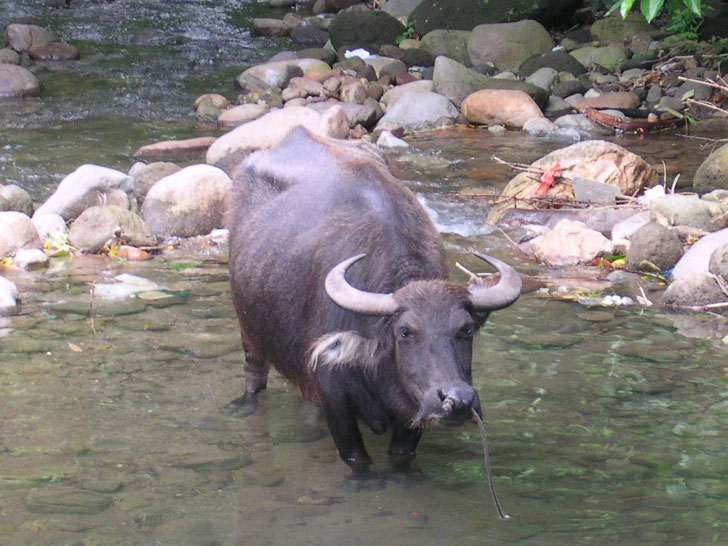- Carabao
Taxobox
name = Carabao
status = DOM

image_width = 200px
image_caption = A carabao in thePhilippines
regnum =Animal ia
phylum = Chordata
classis =Mammal ia
ordo =Artiodactyla
familia =Bovidae
subfamilia =Bovinae
tribe = Bovini
genus = "Bubalus "
species = "B. bubalis"
subspecies = "B. b. carabanesis"
trinomial = "Bubalus bubalis carabanesis"
trinomial_authority = (Linnaeus , 1758)The carabao (Filipino: "kalabaw"; Malay: "kerbau") or "Bubalus bubalis carabanesis" is a domesticated subspecies of the water buffalo ("Bubalus bubalis") found in thePhilippines ,Guam , and various parts of Southeast Asia. Carabaos are typically associated with farmers, being the farm animal of choice for pulling the plow and the cart used to haul farm produce to the market.Description
Adult carabaos weigh seven to eight hundred kilograms—almost 2,000 pounds—and have fairly long gray or black hair thinly covering their huge bodies. They have a tuft of hair on their forehead, and at the tip of their tail. Normally, they are silent and docile, but they will give a trembling snort if they are surprised.Both male and female have massive horns. Since the carabao has no sweat glands, it cools itself by lying in a waterhole or mud during the heat of the day. Mud, caked on to its body, also protects it from bothersome insects.
The carabao eats grass and other vegetation, feeding mainly in the cool of the mornings and evenings. In some places of the world the carabao is a source of milk just like the cow, or it may be slaughtered for its hide and its meat. Its life span is 18 to 20 years and the female carabao can deliver one calf each year.
Carabaos are indigenous to
Southeast Asia .In Guam
The carabao is considered a national symbol of
Guam . They were imported from the Philippines in the late 1600s during the Spanish colonial administration of Guam as a beast of burden and as a means of transportation. They were used for farming and to pull "carabao carts." As recently as the early 1960s, carabao races were a popular sport in the island, especially during fiestas.Today, carabaos are a part of the popular culture in this American territory. Carabaos are often brought to carnivals or other festivities and used as a popular ride for kids. Carabao meat is sometimes eaten as a delicacy, although this is not common these days.
While carabaos were fairly common in Guam before the 1900s, with a population numbering in the thousands, today they are rare in most parts of the island. The exception is in the U.S. Naval Magazine in the village of
Santa Rita , where the carabaos were protected from hunters as the Naval Magazine is fenced on all sides. The carabao population of Naval Magazine has grown to several hundred, to the point that they have become a pest and cause environmental damage and pollute the Naval water supply in the Fena Reservoir. In 2003, the Navy, in a controversial move that was protested by manyChamorro people , began a program of extermination to control the carabao population of Naval Magazine.In the Philippines
Although there is no law that decrees the carabao to be a national symbol in the
Philippines it is generally considered by most Filipinos to be their national animal. Government agencies have come together to improve the marketability of the species.Water buffalo have been domesticated in the Philippines as far back as pre-Hispanic times and are often used by farmers in the Philippines to plow the fields and as a means of transportation. The carabao is one of the most important animals in the country, especially in agriculture. The old “payatak” method of farming is still the method of choice in
Northern Samar . The soil of the rice paddy is first softened with rainwater or diverted watershed, then the farmer guides a group of carabaos in trampling the planting area until it is soggy enough to receive the rice seedlings. This time consuming task produces lower yields and lower income when compared with the advancement in irrigated fields. [ [http://newsinfo.inquirer.net/breakingnews/regions/view_article.php?article_id=83283 Philippine Daily Inquirer, 8-18-2007.] ]Bonsai carabao
A
bonsai ordwarf carabao (34inches in height and 60 inches in length), called "Dagula," was bred inTarlac ,Philippines . It is anoffspring of a native carabao andBulgaria nbuffalo . [ [http://www.gmanews.tv/video/25265/Tarlac's-'bonsai'-Carabao gmanews.tv/video,Tarlac's 'bonsai' Carabao, 07/04/2008] ]In Malaysia
Kerbau is the official animal identity of
Negeri Sembilan . [ms http://www.mpsns.gov.my/mps_v2/BM/psr_identiti.htm]In popular culture
In the late 1980s, a Philippine-made contemporary carabao puppet character, named "Kardong Kalabaw", became popular. This beloved character came to symbolize the Filipino people's hard work and sense of industry. [Citation
url=http://www.filipinojournal.com/v2/index.php?pagetype=read&article_num=10242007004700&latest_issue=V21-N20
title=May Natutunan Ka Ba kay Kiko Matsing?
publisher=The Filipino Journal
author=Alfie Vera Mella
accessdate=2007-12-18 ]The children's
mascot of thePhilippine Daily Inquirer , "Guyito", is a carabao. [ [http://www.inquirer.net/junior/nov99wk3/jun_main.htm Philippine Inquirer Junior, 11-20-1999.] ]A Guamanian Christmas song called "Jungle Bells", sung to the tune of "
Jingle Bells ", makes reference to riding a "carabao cart today" instead of the "one-horse open sleigh" in the traditional song.Colorful, painted, fiberglass carabaos can be seen in the capital of Guam,
Hagåtña , as well as other locations, such as the Guam Premier Outlets inTamuning .See also
*
Domestic buffalo
*Tamaraw
*Water buffalo rumen ecology
*Philipine Carabao Center External links
* [http://newsinfo.inquirer.net/breakingnews/regions/view/20080126-115028/Carabao-may-be-key-to-biofuel-says-scientist Inquirer.net, Carabao may be key to biofuel, says scientist]
References
Wikimedia Foundation. 2010.
